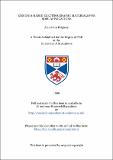Files in this item
Optical fibres in pre-detector signal processing
Item metadata
| dc.contributor.advisor | Maitland, Arthur | |
| dc.contributor.advisor | Herbert, French | |
| dc.contributor.advisor | Phil, Sutton | |
| dc.contributor.author | Flinn, A.R. | |
| dc.coverage.spatial | 266 p. | en_US |
| dc.date.accessioned | 2018-05-30T08:32:26Z | |
| dc.date.available | 2018-05-30T08:32:26Z | |
| dc.date.issued | 1989-07 | |
| dc.identifier.uri | https://hdl.handle.net/10023/13599 | |
| dc.description.abstract | The basic form of conventional electro-optic sensors is described. The main drawback of these sensors is their inability to deal with the background radiation which usually accompanies the signal. This 'clutter' limits the sensors performance long before other noise such as 'shot' noise. Pre-detector signal processing using the complex amplitude of the light is introduced as a means to discriminate between the signal and 'clutter'. Further improvements to predetector signal processors can be made by the inclusion of optical fibres allowing radiation to be used with greater efficiency and enabling certain signal processing tasks to be carried out with an ease unequalled by any other method. The theory of optical waveguides and their application in sensors, interferometers, and signal processors is reviewed. Geometrical aspects of the formation of linear and circular interference fringes are described along with temporal and spatial coherence theory and their relationship to Michelson's visibility function. The requirements for efficient coupling of a source into singlemode and multimode fibres are given. We describe interference experiments between beams of light emitted from a few metres of two or more, singlemode or multimode, optical fibres. Fresnel's equation is used to obtain expressions for Fresnel and Fraunhofer diffraction patterns which enable electro-optic (E-0) sensors to be analysed by Fourier optics. Image formation is considered when the aperture plane of an E-0 sensor is illuminated with partially coherent light. This allows sensors to be designed using optical transfer functions which are sensitive to the spatial coherence of the illuminating light. Spatial coherence sensors which use gratings as aperture plane reticles are discussed. By using fibre arrays, spatial coherence processing enables E-0 sensors to discriminate between a spatially coherent source and an incoherent background. The sensors enable the position and wavelength of the source to be determined. Experiments are described which use optical fibre arrays as masks for correlation with spatial distributions of light in image planes of E-0 sensors. Correlations between laser light from different points in a scene is investigated by interfering the light emitted from an array of fibres, placed in the image plane of a sensor, with each other. Temporal signal processing experiments show that the visibility of interference fringes gives information about path differences in a scene or through an optical system. Most E-0 sensors employ wavelength filtering of the detected radiation to improve their discrimination and this is shown to be less selective than temporal coherence filtering which is sensitive to spectral bandwidth. Experiments using fibre interferometers to discriminate between red and blue laser light by their bandwidths are described. In most cases the path difference need only be a few tens of centimetres. We consider spatial and temporal coherence in fibres. We show that high visibility interference fringes can be produced by red and blue laser light transmitted through over 100 metres of singlemode or multimode fibre. The effect of detector size, relative to speckle size, is considered for fringes produced by multimode fibres. The effect of dispersion on the coherence of the light emitted from fibres is considered in terms of correlation and interference between modes. We describe experiments using a spatial light modulator called SIGHT-MOD. The device is used in various systems as a fibre optic switch and as a programmable aperture plane reticle. The contrast of the device is measured using red and green, HeNe, sources. Fourier transform images of patterns on the SIGHT-MOD are obtained and used to demonstrate the geometrical manipulation of images using 2D fibre arrays. Correlation of Fourier transform images of the SIGHT-MOD with 2D fibre arrays is demonstrated. | en_US |
| dc.language.iso | en | en_US |
| dc.publisher | University of St Andrews | |
| dc.subject.lcc | TK5102.5F6 | |
| dc.subject.lcsh | Signal processing | |
| dc.title | Optical fibres in pre-detector signal processing | en_US |
| dc.type | Thesis | en_US |
| dc.type.qualificationlevel | Doctoral | en_US |
| dc.type.qualificationname | PhD Doctor of Philosophy | en_US |
| dc.publisher.institution | The University of St Andrews | en_US |
This item appears in the following Collection(s)
Items in the St Andrews Research Repository are protected by copyright, with all rights reserved, unless otherwise indicated.

